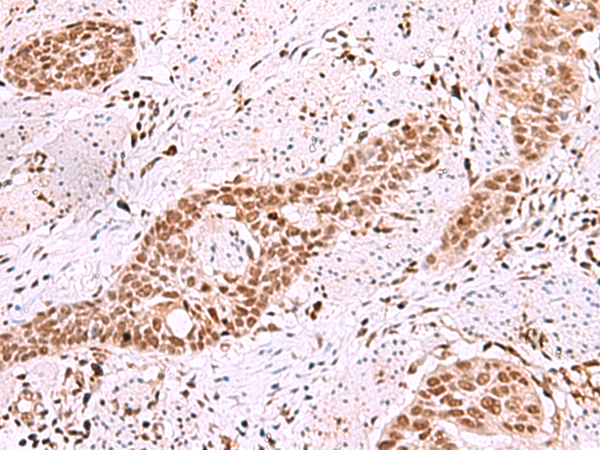
| WB | 咨询技术 | Human,Mouse,Rat |
| IF | 咨询技术 | Human,Mouse,Rat |
| IHC | 1/40-1/200 | Human,Mouse,Rat |
| ICC | 技术咨询 | Human,Mouse,Rat |
| FCM | 咨询技术 | Human,Mouse,Rat |
| Elisa | 1/5000-1/10000 | Human,Mouse,Rat |
| Host/Isotype | Rabbit IgG |
| Antibody Type | Primary antibody |
| Storage | Store at 4°C short term. Aliquot and store at -20°C long term. Avoid freeze/thaw cycles. |
| Species Reactivity | Human, Mouse, Rat |
| Immunogen | Synthetic peptide of human ISL2 |
| Formulation | Purified antibody in PBS with 0.05% sodium azide and 50% glycerol. |
+ +
以下是关于ISL2抗体的3篇参考文献示例(内容为示例性概括,具体文献需根据实际检索确认):
---
1. **文献名称**:*ISL2 is required for retinal ganglion cell axon guidance during development*
**作者**:Tanaka, H., et al.
**摘要**:本研究利用ISL2抗体进行免疫组化,发现ISL2在视网膜神经节细胞中特异性表达,并调控其轴突向视顶盖的导向过程,提示ISL2在视觉系统发育中的关键作用。
---
2. **文献名称**:*Combinatorial roles of transcription factors in motor neuron differentiation*
**作者**:Pfaff, S.L., et al.
**摘要**:通过ISL2抗体的Western blot和免疫荧光分析,揭示了ISL2与其他转录因子(如ISL1和HB9)协同调控脊髓运动神经元分化的分子机制。
---
3. **文献名称**:*Altered expression of ISL2 in amyotrophic lateral sclerosis models*
**作者**:Lee, J., et al.
**摘要**:研究利用ISL2抗体检测神经退行性疾病模型中ISL2蛋白水平的变化,发现其在运动神经元变性过程中表达下调,可能与疾病病理相关。
---
如需具体文献,建议通过PubMed或Google Scholar以“ISL2 antibody”或“ISL2 function”为关键词检索,并筛选涉及抗体应用的研究。
The ISL2 antibody is a research tool targeting the ISL LIM homeobox 2 (ISL2) protein, a transcription factor critical in developmental biology. ISL2 belongs to the LIM-homeodomain family, characterized by two LIM zinc-binding domains and a DNA-binding homeodomain. It plays regulatory roles in cell differentiation, axon guidance, and tissue patterning, particularly in the nervous system. During embryogenesis, ISL2 is expressed in subsets of retinal ganglion cells, spinal motor neurons, and sensory neurons, where it influences cell fate determination and neuronal circuit formation.
ISL2 antibodies are widely used in immunohistochemistry (IHC), immunofluorescence (IF), and Western blotting (WB) to study ISL2's spatial-temporal expression and function in developmental models. Researchers employ these antibodies to explore neurodevelopmental disorders, retinal degeneration, and motor neuron diseases. For instance, ISL2 knockdown or mutation studies link it to axonal pathfinding defects in the visual system and motor coordination impairments.
Commercial ISL2 antibodies are typically raised against specific epitopes in human or murine ISL2. validated for species cross-reactivity. Proper controls (e.g., knockout tissues) are essential to confirm specificity due to potential cross-reactivity with homologous proteins like ISL1. Recent studies also implicate ISL2 in cancer progression, expanding its relevance beyond developmental contexts. As a key marker in neuroscience and developmental research, ISL2 antibodies remain vital for dissecting molecular mechanisms underlying health and disease.
×